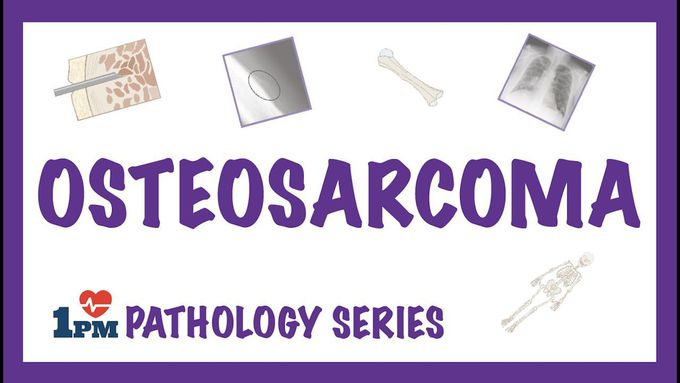


Osteosarcoma - Pathology, Symptoms, Diagnosis, Treatment
Osteosarcoma represents one of the most common primary tumors of bone. Even though the bones vary in size and shape, they are all made of the same types of cells, and chief among them are osteoblasts which build up new bone. And osteosarcomas arise from osteoblasts of different sizes and these cells produce too much osteoid tissue which is the unmineralized, organic portion of the bone matrix that forms prior to the maturation of bone tissue. This is why osteosarcoma is called a bone-forming tumor. Now, this image shows the age distribution of osteosarcoma. Osteosarcoma has a bimodal age distribution; 75% of osteosarcomas occur in persons younger than 20 years of age. The smaller second peak occurs in older adults, who frequently suffer from conditions known to predispose to osteosarcoma. So what are the causes of osteosarcoma ? Approximately 70% of osteosarcomas have acquired genetic abnormalities such as complex structural and numerical chromosomal aberrations. Molecular studies have shown that these tumors usually have mutations in well-known tumor suppressors and oncogenes: With mutations, proto-oncogenes become oncogenes, and these overstimulate the cell growth. To balance out cell growth, there are other genes called tumor suppressor genes which promote apoptosis or cell death of mutated cells. So oncogenes or mutated tumor suppressor genes allow cells to keep growing uncontrollably resulting into tumors. Some known mutations that are linked to osteosarcomas include mutations in the pRB protein and the p53 protein. Osteosarcoma can arise in any bone in the body, but there is a striking propensity for this tumor to occur in the metaphyseal regions of the long bones. And also the distal femur, proximal tibia, and proximal humerus represent the most common sites of involvement.
What is Rheumatoid Arthritis? | Johns Hopkins RheumatologyAnkylosing Spondylitis | HLA-B27, Pathophysiology, Signs & Symptoms, Diagnosis, TreatmentWhat is scoliosis?OsteosarcomaExternal nose bones

